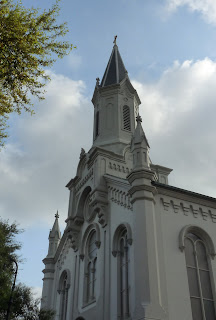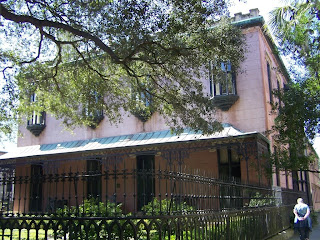In mid-April, on our way to visit relatives in Florida, we spent 24 hours in Savannah GA, trying to take in all the history and the beauty of this city built on a bluff above the Savannah River. The British General James Oglethorpe first landed in this spot in 1733 and created an innovative and now famous city plan based on a system of squares. In his grid-like model of urban planning, homes, churches and businesses surround each square, creating a network of interconnected neighborhoods. Thanks to a strong preservation effort, 33 of the city's orginal 24 squares remain - each with its own distinctive style.
Our first stop in Savannah was the visitors' center, where we hopped on a trolley for a quick overview of the city. It was a good way to learn how the city is laid out, plus we had the added bonus of meeting one of Savannah's more famous residents, Forrest Gump. Our driver spotted him on the sidewalk; he hopped aboard for a short ride.
After our trolley tour, we walked over much of the same territory and more. Savannah is a great place for walking - nice wide sidewalks, lots of shade from old oak trees - and in spring, plenty of azaleas and other flowers in bloom.
There is history on every corner - here is some of what we saw ... or at least some of what we remember that we saw ....
The Cathedral of St. John the Baptist is located in Lafayette Square. This French-Gothic style cathedral was founded in1799.
The Telfair Museum is said to be the oldest public art museum in the south. It includes a sculpture garden that is now the home of the "Bird Girl" from the book and movie "Midnight in the Garden of Good and Evil."
Colonial Park Cemetery is the city's only non-active cemetery, meaning that no more burials take place here. Many of Savannah's earliest settlers are buried here, with gravestones dating back to the 1700's.
Savannah's historic squares are scattered around the old part of town - delightful green spots, some with monuments, some with fountains, and all with towering live oaks, spanish moss and flowers. Here is a shot of Pulaski Square, named after the Revolutionary War hero - one of the few squares without a monument or a fountain.
In addition to the squares, Savannah also has some lovely parks. One of the most famous is also the city's first park - Forsyth Park. Its design was influenced by the urban renewal of Paris in the nineteenth century, when broad boulevards and parks were created. The Forsyth Park fountain is a copy of the one in the Place de la Concorde in Paris and the fountain served as a focal point of a long vista, all the way to the Cotton Exchange.
Victorian homes line the streets around Forsyth Park.
Ascension Lutheran Church was founded in 1741; it faces Wright Square. It is known for its architecture and beautiful stained glass.
The Savannah Cotton Exchange building was constructed in 1887, when Savannah ranked as the second busiest cotton seaport in the U.S. Originally called King Cotton's Palace, it was built over Factor's Walk, where cotton traders and merchants did business. In its heyday, over two million bales a year moved through Savannah, and the Cotton Exchange was the center of activity in the staple which dominated this city's economic life.
Factor's Walk today is a collection of iron walkways, stairways and cobblestone ramps that connect Bay Street (which runs along the edge of the bluff overlooking the river) to the Savannah River level.
River Street is nearly a mile of shopping, bars and restaurants along the Savannah River. It seems to be where the tourists hang out and is the main hub of the city's annual St. Patrick's Day celebration.
Savannah's City Hall was built in the early 1900's. Its dome, which rises 70 feet into the air, was originally clad in copper, but was gilded in 1987 through a gift from a local philathropist. Talk about having more money than you know what to do with!
Fanning out from the river, Savannah's historic district is like walking through a living museum of beautfiul old homes. It seems like every one has a story to tell and we heard so many stories that we can't remember many of them.
This house is the birthplace of Juliette Gordon Low, the founder of the Girl Scouts. The building has been restored to its 1800's appearance and hosts tours for troops of Brownies and Girl Scouts.
The Davenport House is a Federal-style home, built between1815 and 1820. If faces Columbia Square and is famous mostly because of its role in launching Savannah's historic preservation movement in the 1950's.
This is the Sorrel-Weed House, one of the first houses in Georgia to be designated an historic landmark. It also has the reputation of being the most haunted house in Savannah.
The Green-Meldrim Mansion is a fine example of neo-Gothic architecture but is best known as General Sherman's Civil War Headquarters. Next door, towering over the trees, is St. John's Episcopal Church whose bells were rung at all hours of the day and night for the express purpose of driving the yankees a little crazy.

The Mercer-Williams House was designed by John Norris for General Hugh Mercer, great-grandfather of the songwriter Johnny Mercer. Later, it was the home of Jim Williams, the antiques dealer immortalized in "Midnight in the Garden of Good and Evil."
Less famous, unnamed houses - still interesting - in many of the houses, the main entrance is up a flight of stairs, above the level of the street.
This three-story white house isn't famous yet, but just wait a while. This is the home of our friend Rick Pryor, who is doing a massive interior renovation here. We distracted Rick from his work for a few hours by allowing him to take us out to dinner on Tybee Island/
We ate at the Crab Shack, which really is a shack ... but the food is out of this world. A special thanks to Rick for a perfect ending to a great day in Savannah, Georgia's first city.





























No comments:
Post a Comment